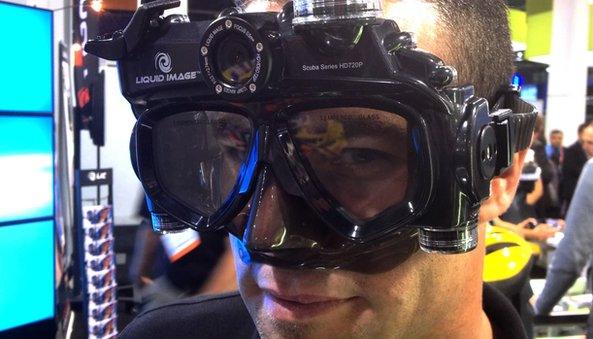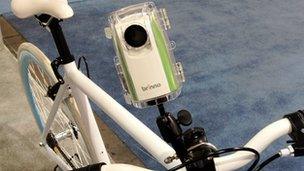How tiny cameras have become big business
- Published

Low-cost cameras are being used for many purposes - including underwater film making
If you are a fan of action sports you have probably already noticed that putting tiny cameras on people's heads - and in other unlikely locations - has become big business.
As video technology has become smaller and the image quality has got better, these devices are producing visually stunning video clips that are so fast and frenetic, it leaves the viewer somewhat disorientated yet in awe of the feats accomplished by the individual attached to the camera.
With these gadgets we all have the same view as a champion snow boarder dropping down a cliff face, or a motorcycle stunt rider rotating his way out of a "certain death" situation.
It is exciting to watch.
So it is not surprising that the "take a pair of eyes anywhere" philosophy behind the small action sports cameras has intrigued professionals who have long looked for a method of capturing their surroundings in an easy and convenient way.
Mountain bikers
For years, police cars have been outfitted with cameras and microphones collecting fuzzy footage and scratchy audio that had limited use.
But now one company, Pivothead, is putting superior technology into sunglasses worn by highway patrol officers in places like Austin, Texas. The glasses are able to capture the details of a driver's face in high-definition and record conversations at higher bit rates using smaller, more precise microphones.
Pivothead's Zach Barbitta says the benefits are many.
"For some professionals it mitigates insurance premiums. No longer does a police officer have to spend his time in court justifying a drunk driver - it was all captured on Pivothead.
Pilots fly and use the footage as training tools. Military personnel have control of protests and can analyze the footage."

The Brinno camera takes a picture once a second
Lifeguards use them on the beach to record unfolding events; ski patrols can capture the scene of an accident and play it back for anyone who needs to see it, such as doctors and safety inspectors; coaches can use the glasses to analyse gameplay or athlete performance.
Brinno Inc starting making a video camera specially for front mounting onto bicycles.
The engineers behind the TLC200 were keen to record multi-day bike rides, but had found the typical 30 frames-per-second HD sports cameras consumed too much battery power and memory.
The gadgets simply fizzled out after a couple of hours use. The video camera they created lasted seven days on one charge, taking one frame every second - still a satisfactory way to remember any bike ride.
More importantly the efficiency of the unit has made it appealing to law enforcement agencies, including the police department in Newport Beach, California.
The camera is mounted on bicycles and is set to record three frames per second, the lowest frame rate allowed as evidence in courts, according to Chris Adams, from Brinno Inc, who says other professionals, including teachers, have found it very useful.

Police have used cameras to record footage for years, but the picture quality was always grainy
"The number of applications this is being used for beyond hobbyists is mind boggling," he said.
"It is being used in science classrooms where it has replaced a $4,000 camera on microscopes that sent the image to a screen for all the children to see. We can do it wirelessly for less than $300."
The company did not initially target classrooms with any marketing campaigns. It all happened via word of mouth in a profession where budgets are being slashed all across America.
Cirque de Soleil
Filming with 360 degree video cameras is one of the fastest growing segments of the sports camera scene. But again professionals have found their own uses for this type of camera.
Real estate agents have used it to show off properties - potential buyers sitting at home in front of a computer screen can use the mouse to look at every corner of a room or to see what the view is like over the balcony, external.
War correspondents have also found it a compelling way to capture the chaos around them. The Geonaute 360 with three outward facing lenses is designed to sit atop a helmet and record activity in every direction.
At a recent trade show in America some unexpected guests showed up to take a look at it, surprising Marian Le Calvez, the communications manager at France based Geonaute.

Word of mouth led to the Brinno microscope being adopted in schools
"The people from Cirque de Soleil dropped by our booth. We really like those guys and what they do, so we went to see them and they were really interested to get hold of one to use in a scene."
But even the greatest circus show on Earth will have to wait a bit longer.
The camera is not yet for sale, but when it is released it is likely to cost around $299 (£200). It is this kind of price point that often makes professionals take a second look.
For example, Dan Silveira uses a pair of diving goggles from Liquid Image with a built-in HD camera to record underwater scenes for his TV show about spear fishing.
The cost of producing such a show ten years ago, with complex filming rigs and bulky equipment, would have been prohibitive.
Inevitably, with the increasing popularity of potentially intrusive technology, there are people who worry about our ever-shrinking right to privacy.
Celebrities and politicians could easily be targeted by those looking to collect some juicy candid conversation.
In America the laws regarding one-way monitoring and recording vary from state to state.
As the equipment becomes cheaper and more appealing in the professional world, those regulations are likely to be tested by both sides.